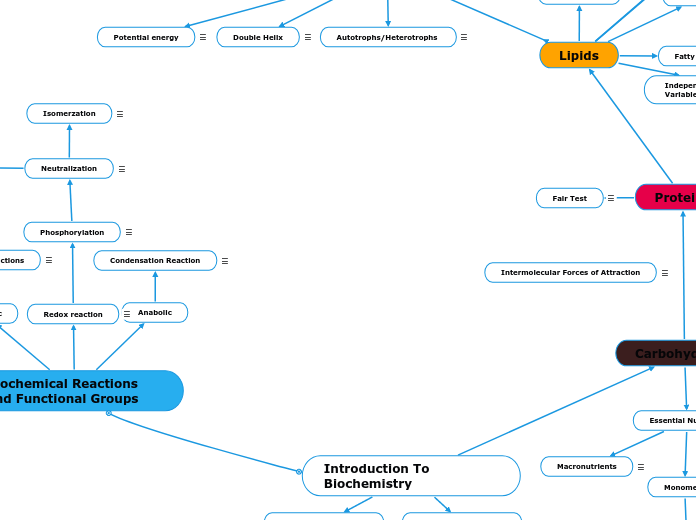Introduction To Biochemistry
Intermolecular Forces
London Dispersion Forces (Van Der Waals Forces )
Hydrogen Bonds
Dipole-Dipole Forces
Ion-Dipole Forces
Carbohydrates
Essential Nutirenst
Monomers
Polymers
Glycosdic Linkage
Disaccharides
Oligosaccharides
Polysaccharides
Macronutrients
Monosaccharides
Aldose and Ketose
Isomers
Proteins
Amino acids and Essential Amino Acids
R-groups
Peptides/Polypeptides
Primary,Secondary,Tertiary,Quaternary Structures
Hydrophobic/philic
Lipids
Fatty acids
Glycerol
Waxes
Amphipathic
Micelle
Bilayer
Triglyceride
Phospholipids
Steroids
Mosaic
Glycolipid/protein
Transmembrane Protein
Nucleaic Acid
Nucleotide
Phosphodiester Bond
Nitrogenous Base
Ribose/Deoxyribose
ATP
NAD+/NAPD+/FAD+
Autotrophs/Heterotrophs
Double Helix
Potential energy
Independent/Dependent, and Controlled Variables
Fair Test
Neurotransmitter
Hormones
Intramolecular Forces
Ionic Bonding
Non-polar/Polar
Covalent Bonding
Biochemical Reactions and Functional Groups
Hydroxyl Group
Sulfhydryl Groups
Carbonyl Group
Phosphate group
Aldehyde
Ketones
Enzymes
Reactants
Product
Catabolic
Hydrolysis Reactions
Glycosidic
Anabolic
Condensation Reaction
Redox reaction
Phosphorylation
Neutralization
Isomerzation
Ester/Amide/Phosphodiester
